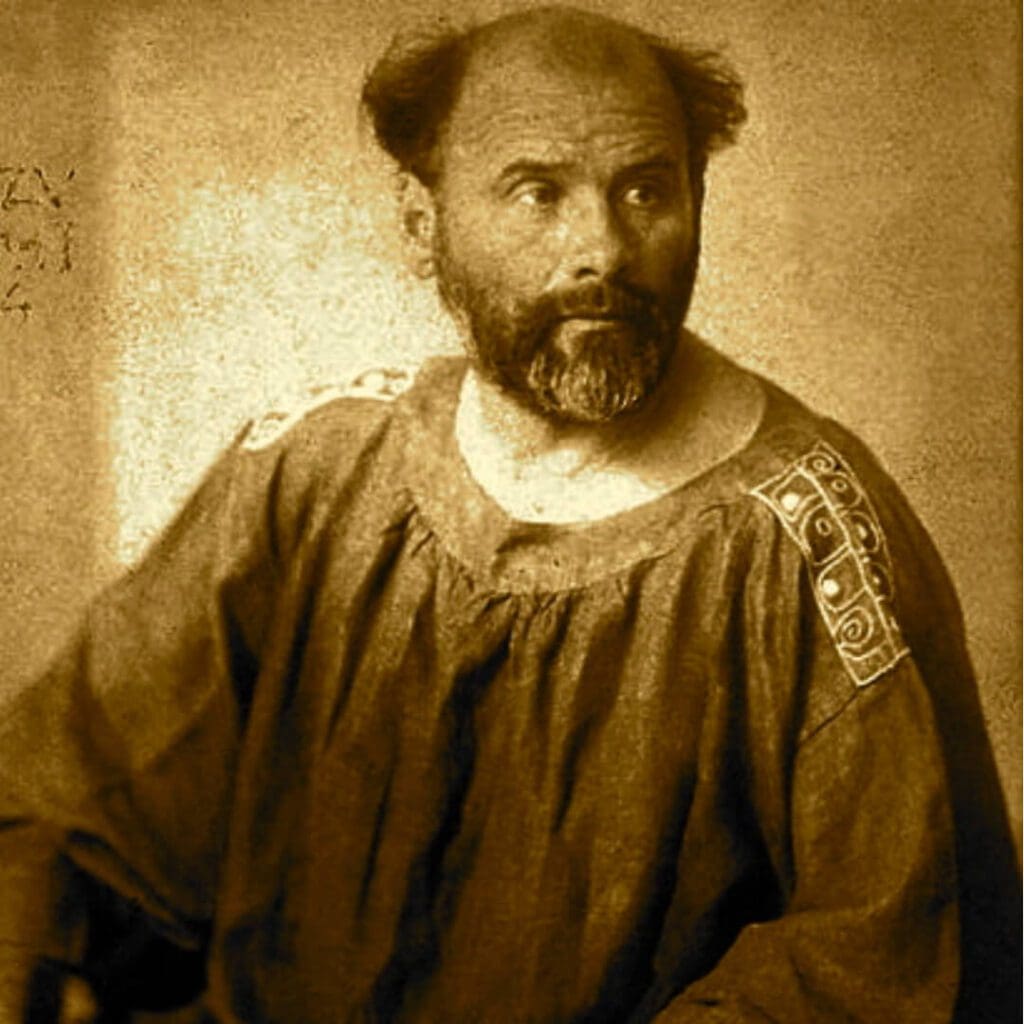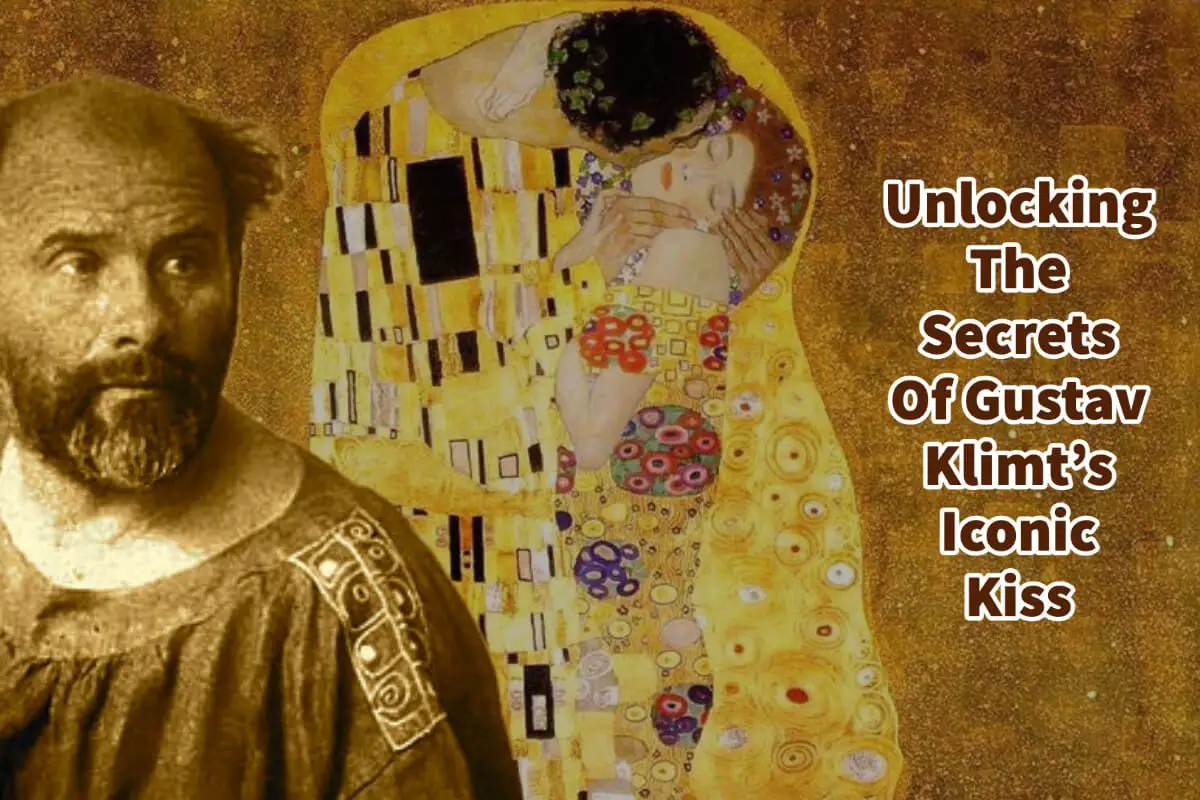One of the most iconic paintings is Gustav Klimt’s “The Kiss.” This painting had rightfully earned its place as one of the world’s most important works of art.
The Kiss is one of Gustav Klimt’s most celebrated artworks; it was painted from 1907 to 1908. The painting is filled with intricate details and gold leaf. The Kiss by Gustav Klimt depicts a couple locked in a passionate embrace, with the man kissing the woman on her cheek. The painting shows Gustav Klimt’s unique artistic style.
Table of Contents
- Who Is Gustav Klimt?
- The Kiss Is One of Gustav’s Most Iconic Artworks
- Frequently Asked Questions
- Related Content
Who Is Gustav Klimt?
Gustav Klimt is considered one of the greatest artists of the 20th century, known for his unique style and contributions to the Art Nouveau movement. Born in Austria in 1862, Klimt lived and worked in Vienna for much of his life, eventually becoming one of the most celebrated artists of his time.

He was a member of the Vienna Secession movement, a group of artists dedicated to breaking free from the traditional style of art that had dominated the Austrian art scene for centuries.
The Kiss Is One of Gustav’s Most Iconic Artworks
One of Klimt’s most iconic works is “The Kiss,” that was painted between 1907 to 1908 during his artistic “Golden Phase.” The painting depicts a couple locked in a passionate embrace, with the man kissing the woman on the cheek. The painting is known for its intricate, detailed patterns and the use of gold leaf – all a hallmark of Klimt’s style.

10 Significant Reasons Gustav Klimt’s “The Kiss” Is Important
The Kiss, is one of the most important and legendary artworks for its time. There are several important aspects of “The Kiss” that make it an essential work of art.
Here are 10 reasons why “The Kiss” by Gustav Klimt is so signficant:
The Couple
The couple in “The Kiss” is the central focus of the painting. The woman is dressed in a flowing gown, with her head tilted back, while the man stands behind her and embraces her.
The couple’s pose is intimate and passionate, which is a departure from the more reserved poses in traditional art during this time.
The Use Of Gold Leaf
Klimt used gold leaf to create the intricate patterns that cover much of the painting. The gold leaf adds a sense of opulence and luxury to the painting, while reflecting the Art Nouveau movement’s focus on beauty and aesthetics.
The Patterned Background
The background of “The Kiss” is covered in intricate, abstract patterns. The patterns are meant to represent the couple’s passion and the sense of energy that surrounds them.
The Decorative Elements
In addition to the gold leaf and the patterns, “The Kiss” also features several decorative elements, including the woman’s hair and the man’s clothing. These elements add to the sense of opulence and luxury that is present throughout the painting.
The Color Palette
Klimt used a muted color palette for much of the painting, with shades of gold, white, and black dominating. This gives the painting a sense of elegance and sophistication.
The Symbolism
“The Kiss” is filled with symbolism, including using gold leaf to represent the divine and the patterns to represent the couple’s passion. The painting also symbolizes love and the human desire for intimacy and connection.
The Composition
The composition of “The Kiss” is carefully balanced, with the couple at the center of the painting and the patterns and decorative elements framing them.
The Contrast
Klimt used a strong contrast between light and dark in “The Kiss,” with the gold leaf and patterns standing against the background. This creates a sense of depth and dimensionality.
The Sense Of Movement
“The Kiss” is filled with movement and energy, with the patterns and decorative elements swirling around the couple. This adds to the sense of passion and intimacy in the painting.
The Legacy
“The Kiss” has become one of the most iconic works of art in history. The artwork has profoundly impacted the world of art and beyond; it has been reproduced countless times and continues to inspire artists and art lovers worldwide.
Gustav Klimt’s “The Kiss” is a masterpiece of art that has captivated audiences for over a century. Its intricate patterns, use of gold leaf, and symbolism have made it an enduring symbol of love and passion. Its composition and sense of movement add to its dynamic quality, while its legacy has ensured that it remains one of history’s most important works of art.
Unlocking the secrets of “The Kiss” requires an appreciation of Klimt’s unique style and the Art Nouveau movement in which he was a key figure. It also requires an understanding of the various aspects of the painting that make it so important.
By exploring the use of gold leaf, the decorative elements, the symbolism, and other features of the painting, we can gain a deeper appreciation of its beauty and significance.
“The Kiss” is a testament to the power of art to capture the human experience and evoke emotions that transcend time and place. Its enduring appeal is a testament to Klimt’s talent and the timeless themes of love and intimacy it represents.
Anita Louise Art is dedicated to art education, great artists, and inspiring others to find and create their art. We love art that uplifts and inspires. #ArtToMakeYouSmile! #ArtToMakeYouHappy!
If you are interested to see any of my art, you can find out more by clicking here. If you are interested in what inspires me and my paintings, you can discover more by clicking here.
We have a free newsletter and would love you to be part of our community; you can subscribe to the newsletter by clicking here. I would be happy to talk to you if you have any questions. You can reach me, Anita, by clicking here.
Subscribe to our Anita Louise Art YouTube Channel with great videos and information by clicking here.
Join us for our podcast “5 Minutes With Art.” Spend just 5 minutes a week with us to discover and learn about great art and artists. You can find out more about our podcast by clicking here.
Frequently Asked Questions
What inspired Gustav Klimt to create “The Kiss”?
Gustav Klimt’s inspiration for “The Kiss” is believed to be a combination of his fascination with symbolism, love, and his exposure to Byzantine art during his travels. The painting reflects the Art Nouveau movement’s emphasis on ornate and decorative elements.
What is the significance of the gold leaf in “The Kiss”?
The extensive use of gold leaf in “The Kiss” is a hallmark of Gustav Klimt’s style. It symbolizes spiritual and eternal love, drawing influence from Byzantine mosaics. The gold leaf adds a luxurious and radiant quality to the artwork.
What is the meaning behind the intertwined figures in “The Kiss”?
The intertwined figures in “The Kiss” represent the unity of love and the intimate connection between a man and a woman. The couple’s embrace symbolizes the idealized and harmonious nature of a romantic relationship.
How did Gustav Klimt’s personal life influence “The Kiss”?
Gustav Klimt’s personal life, marked by numerous romantic relationships, likely influenced the themes of love and passion in “The Kiss.” His experiences with love and desire are thought to have inspired the emotional intensity portrayed in the painting.
What techniques did Gustav Klimt use in creating “The Kiss”?
Gustav Klimt employed a unique blend of symbolism, allegory, and ornamental elements in creating “The Kiss.” The use of geometric shapes, intricate patterns, and a rich color palette, along with the application of gold leaf, showcases his mastery of various artistic techniques.
How did the art world and public react to “The Kiss” when it was first unveiled?
When “The Kiss” was first exhibited, it received mixed reactions from the art world and the public. Some admired Klimt’s innovative style, while others found the overtly sensual and decorative aspects controversial. Over time, however, it gained widespread acclaim.
Are there hidden symbols in “The Kiss” that viewers might overlook?
Yes, “The Kiss” is filled with symbolic imagery. The geometric patterns, spirals, and symbols in the background hold meanings related to life, death, and the cyclical nature of existence. These symbols contribute to the overall depth and complexity of the artwork.
What challenges did Gustav Klimt face while creating “The Kiss”?
Gustav Klimt faced challenges during the creation of “The Kiss,” including the initial controversy surrounding his unconventional artistic choices. Additionally, his departure from the traditional academic style of painting faced criticism from more conservative critics of the time.
How has “The Kiss” influenced subsequent art movements and contemporary artists?
“The Kiss” has had a profound influence on subsequent art movements, particularly the Symbolist and Art Nouveau movements. Its impact is evident in the work of various contemporary artists who draw inspiration from Klimt’s innovative use of symbolism and decorative elements.
Where is “The Kiss” currently located, and can it be viewed by the public?
“The Kiss” is housed in the Österreichische Galerie Belvedere in Vienna, Austria. It is a public museum, allowing visitors to marvel at Gustav Klimt’s masterpiece and experience its intricate beauty firsthand. However, it’s always advisable to check for the latest information on the painting’s location and accessibility.
Related Content
Who is the Swedish Artist Hilma af Klint (1862-1944)?
Hilma af Klint was a Swedish woman artist who was painting revolutionary modern artwork for her time. A trailblazing, creative figure who kept her art and paintings secret for many years. Despite her amazing works of art and legacy she left us, it has only been during the last 40 years that she has started to gain international acclaim.
You can discover more by reading our blog Who is the Swedish Artist Hilma af Klint (1862-1944)? by clicking here.
Who Was the Mexican Artist Frida Kahlo (1907-1954)?
Frida Kahlo is one of Mexico’s premier artists. She suffered from polio and was in a bus accident that left her in a lot of pain. Kahlo married the famous Mexican artist Diego Rivera. She is well known for her self-portraits that depict pain and suffering, but are also filled with passion and bright bold vibrant colors. Her art is a personal statement of her life, paint, and culture.
You can discover more by reading our blog Who Was the Mexican Artist Frida Kahlo (1907-1954)? by clicking here.
Who was Henriette Ronner-Knip (1821-1909), Painter of Cats & Dogs?
Henriette Ronner-Knip came from a family of artists. At a very early age, she became in charge of the family’s finances and other legal obligations so she started to paint to earn some income. She sold her first painting at age 15 years old. Later when she was married, her husband became her manager and Henriette continued to paint. Henriette is famous for her many wonderful paintings of cats and dogs. One reason Henriette choose to paint dogs and cats as a subject matter is that during the Victorian era having a pet in your household was popular.
To find out out more about Henriette Ronner-Knip you can read our blog on Henriette Ronner-Knip (1821-1909), Painter of Cats & Dogs, by clicking here.

